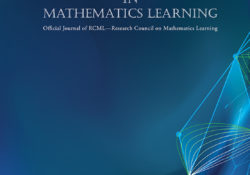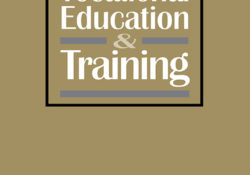tandfonline.com har udgivet en rapport under søgningen “Teacher Education Mathematics”: ‘I loved exploring a new dimension of reality’ – a case study of middle-school girls encountering Einsteinian physics in the classroom Link til kilde
Like this:
Like Loading...
tandfonline.com har udgivet en rapport under søgningen “Teacher Education Mathematics”: ABSTRACT ABSTRACT The research apprenticeship is a situated form of learning that can be effective in connecting learners to science. It is commonly assumed that this pathway is characterised by power transitions from those positioned as experts to those positioned as novices, yet power and positionality during a research apprenticeship have rarely been explicitly investigated. Using a qualitative approach, we explored this area in the context of a summer research apprenticeship for girls, involving primarily female scientist mentors. We found that scientist mentors positioned, and were positioned by, learners in three different ways, and that these positionalities were associated with different kinds of identity work among learners. Given stereotypical societal views of science that can be at odds with gendered… Continue Reading →
Like this:
Like Loading...
eric.ed.gov har udgivet: Throughout much of the world, boys continue to outscore girls on standardized mathematics tests. For example, in most of the 57 countries that participated in the Programme for International Student Assessment (PISA) 2006, boys’ performance was significantly higher than girls on the mathematics scale. This fact alone can harm girls’ opportunities for competitive scholarships and entry into top colleges, attitudes toward the subject matter and themselves, and participation in mathematics-oriented occupations. Intervention programs are equitable measures for addressing the needs of special populations. They can have successful results in bolstering the knowledge, dispositions, and participation of underrepresented groups in domains in which they are marginalized. In this article, the author describes a mathematics and technology intervention program for middle-grades girls. This description of the Northern Nevada Girls’… Continue Reading →
Like this:
Like Loading...
eric.ed.gov har udgivet: This is a handbook intended for use at a 1-day conference for 170 seventh and eighth grade girls, their parents, counselors, and math/science teachers. It is meant to stimulate interest in exploring career options in mathematics and science related areas. Sections included are: (1) “Introduction”; (2) “Conference Objectives”; (3) “Promotion/Recruitment”; (4) “Conference Day Format” (presenting the procedures and handout materials of the 1-day program); (5) “Recommendations–Do’s and Don’ts”; (6) “Follow-up Activities” (providing materials for the activities); and (7) “Resources” (listing media and organizations). (YP) Link til kilde
Like this:
Like Loading...
eric.ed.gov har udgivet: This digest addresses the issue of sex differences in mathematics achievement in K-12 students. The problem is discussed in three sections. The first section examines the progress that has been made in narrowing the gap between girls’ and boys’ achievement in mathematics and the numbers of women and men who enter mathematics-related careers. Issues addressed include the failure of research to find any inherent differences in girls’ and boys’ abilities in mathematics, the underrepresentation of women in mathematics-related fields, strategies to motivate girls to take more mathematics courses, and strategies to encourage girls to consider mathematical and scientific careers. The second section offers innovative approaches in mathematics education funded by the Women’s Educational Equity Act (WEEA) Project. A list of the products mentioned in the article is… Continue Reading →
Like this:
Like Loading...
eric.ed.gov har udgivet: This brochure, one in a series of four, is designed to assist people working in schools and in the community as they work together to encourage girls in mathematics, science, and engineering. Six sections discuss the reasons for and ways to work together to make changes. The first section describes what special programs can offer schools, and reciprocally, what schools offer special programs. The second section offers a rationale for making changes that will attract more women into mathematics and science related fields. The third section provides seven suggestions, based on evaluation and research, that help make collaboration work, and identifies five practices that, based on experience, should not be done. The fourth section presents a model that has enabled teachers to double the amount of hands-on… Continue Reading →
Like this:
Like Loading...
eric.ed.gov har udgivet: Females are underrepresented in courses in mathematics, science, and computer and other high technology applications. Research in the last decade has identified a variety of factors that contribute to females’ lack of participation in math, science, and technology. These factors include, but are not limited to, the following: stereotypic images and expectations, lack of self-confidence, peer pressure, learning environment, teacher behavior, lack of female role models, failure to see relevance, attributional style or personal responsibility, and lack of incentives. The following strategies can address these issues: (1) parents’, teachers’, and counselors’ efforts to dispel stereotypes; (2) improvement of self-confidence; (3) use of peer pressure by making success in math and science prestigious; (4) enhancement of the learning environment; (5) equalization of teacher behavior; (6) provision of female… Continue Reading →
Like this:
Like Loading...
tandfonline.com har udgivet en rapport under søgningen “Teacher Education Mathematics”: ABSTRACT ABSTRACT Young Black women face dual marginality in the classroom due to longstanding racial and gender stereotypes. However, critical examinations of their academic dispositions remain relatively absent from current discourse on Black student achievement. The mathematics dispositions of Black girls (N = 1707) who completed the High School Longitudinal Study of 2009/2012 (HSLS:09/12) were analyzed through cluster analysis. The results of this study suggest that the mathematics dispositions of young Black women can be characterized in four distinct categories. Within these categories, several trends that carry direct implications for the preparation and motivation of young Black women in mathematics are provided. Link til kilde
Like this:
Like Loading...
tandfonline.com har udgivet en rapport under søgningen “Teacher Education Mathematics”: ABSTRACT ABSTRACT In this study, we focus on the role of Dutch Level 2 senior vocational training in care work in relation to the prospects and options it provides for students who follow this programme. Similar to the ‘care girls’ from previous studies our participants are young women from lower-class backgrounds who aspire to various jobs in the care sector, but are steered away from their original aspirations by their vocational training programme. The major difference between this research and previous studies is that we examine the Dutch institutional and broader structural context of care work. In the Netherlands, there is a lack of job opportunities for Level 2 graduates. This enables us to study the impact of limited job… Continue Reading →
Like this:
Like Loading...
eric.ed.gov har udgivet: This report describes a program created specifically to address the fact that individuals with disabilities, especially girls, have been widely under-served and under-educated in the areas of science, math, and technology. The “Daughters with Disabilities” project was designed to encourage more girls with disabilities from five inner-city schools to prepare for careers in science, math, and technology by: (1) increasing the interests and achievement in science, math, and technology of girls in special education classes at the five participating schools; (2) enhancing existing science, math, and technology curricula for girls with disabilities in urban settings; (3) introducing and teaching the concept of “pre-transition” knowledge in the science, math, and technology areas; and (4) creating a network of support and training for pre-service and in-service special and regular… Continue Reading →
Like this:
Like Loading...



